One of my greatest passions is the music, originally poems authored by King Alfonso X of Castile-Leon, now Spain, from 1252 to 1284. My great love for what the King, referred to “the wise,” or El Sabio, was trying to do with his kingdom, was to bring about unity among Christian, Jewish, and Muslim peoples, though he had inherited separation, and it continued after his death in 1284. Then the Inquisition happened in 1492 along with colonization of the Americas.
What follows here is my transcript for an upcoming holiday special in December. At this point, I know that High Plains Public Radio will run this program, usually, on December 25. We have put it up for national acquisition, so check your local public radio station for listing. I begin, here, with an image of the Learned King, taken in Spain last year by Alfonsine Scholar, Dr. Jessica Knauss.
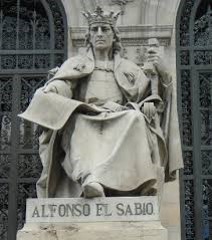
Embedded in this narrative are the songs, their timings, and their performers. You will see pictures as well.
Prologue: Ensemble Unicorn, CSM #60 2:16
Hello. I’m Debra Bolton, and welcome to Las Cantigas de Santa Maria (The Holy Canticles of St. Mary), Songs and poems in praise of Holy Mary – and the poetic/musical biography of Alfonso, “the wise”, who lived from 1221 to 1284. I appreciate your joining me today.
King Alfonso ruled his Kingdom of Castile-Leon, now Spain, from 1252 until his death. We began with Ensemble Unicorn presenting the prologue, which is Cantiga de Santa Maria, which I will refer to as CSM, #60, when the Learned King declares himself Mary’s Troubadour to the “noble lady” and asks her to bestow the inheritance of eternal life and grant Alfonso’s kingdom a place in eternity. Interesting to note, of the 420 Marian poems written by King Alfonso X and his assistants, about every 10th poem is a song of love for the Virgin, and since this is not an “official” prologue, since it has the even number #60, it would also be considered a “cantiga de loor” song of love for Mary.
Now we hear the Prologue of the five festivals, performed by Eduardo Paniagua and his Musica Antigua. Paniagua, a musicologist and an early music instrumentalist, devotes much of his time to researching, performing, and recording the vast catalogue of Las Cantigas de Santa Maria, poems and songs in praise of Holy Mary. This is was from “The Life of Mary” songs of the festivals devoted to her. The number is CSM #410.
CSM #10 Rosa das Rosas, “Cantiga de loor” 4:01
Throughout the life of King Alfonso X, he devoted himself to learning and being surrounded by the learned. He believed a learned King and court with great knowledge of the natural world, mathematics, architecture, human behavior, and great discernment could only benefit the people of his kingdom. Being a pluralist, he employed Christian, Jewish, and Muslim in his court to advance learning.
Let’s turn to the marvelous miracles of Mary found in CSM#37. This is a story of Mary healing a man with a sorely infected and inflamed foot. When Mary went to the church to heal the man, there she found many other who needed healing. The poem tells us that because they believed that Mary would heal them, so it happened. Antequera 6:17
CSM Como Poden Hesperus 3:36
You just heard Hesperus, founded by the late Scott Reiss and Tina Chancey. Named for the Venus and the West Wind, Hesperus specializes in exploring musical parallels between the Old World and the New in what they sometimes call, Medieval Fusion. Band member Tina Chancey continues an active performance and teaching schedule in the Washington DC area with music of the Sefardi.
Later in this program, we will explore how this music continues to inspire musicians, musicologists, historians, and other social scientists.
You’re listening to Las Cantigas de Santa Maria, a musical biography of Spain’s King Alfonso X and his praise to the Virgin Mary. I’m your host, Debra Bolton
Instrumental, CSM #323, Musica Antigua, “Nino de Coria” 3:13
Total Time (music) 25:33
End of Segment 1
Segment 2
You’re listening to Las Cantigas de Santa Maria, the holy canticles of the Virgin Mary in music, poetry, and art. My name is Debra Bolton. I am your host for this special music. If you go out to my website on WordPress, you will find examples of some of the art that corresponds with the songs and poetry. King Alfonso employed artists to create two and three-dimensional works of art to correspond to the poems and songs, which would have made the Learned King an early pioneer in multi-media (Knauss, interview, 2018). Now, here we are putting it all in digital form! Some scholars point of the works of art, the songs and the poems as Alfonso’s way to teach morality to the subjects of his kingdom on many levels. While those in his court were, themselves, learned and well-educated people, there were many in his kingdom who, perhaps, could not read or write. Hence the need for the lessons on morality in more than written forms.
Let’s continue with the miracles performed for the people in Alfonso the X’s Kingdom. Some of the miracles awarded people for their faith while some punished people for their transgressions. We hear CSM#163, “The Gambler who renounced the Virgin.” A gambler, playing dice in Huesca, lost everything and renounced the Virgin. He was instantly crippled and struck dumb. He could not move from that place, and if he wanted something, he had to gesture for it. Using sign language, he asked to be taken to Salas. At Salas, he gazed at the Virgin’s statue and asked her pardon. The Virgin healed him and he praised her from then on. Performed here, by another Alfonsine scholar, Maestro Jordi Savall, and his Hesperion 20 featuring the late soprano, Montseratt Figueres.
CSM# 163 4:53.
Go to Esther Lamandier and CSM #159 Cantiga de Loor 4:56
Back announce Esther Lamandier:
You’re listening to Las Cantigas de Santa Maria, the holy canticles of the Virgin Mary in music, poetry, and art. I’m the producer and your host, Debra Bolton. I began exploring the history of the CSM, because I found the tunes, songs, poems, and art pieces so wonderfully extraordinary with their passion and multimedia approaches. I love the instruments of the time, too.
The poems and songs employ the language of the time, which is Galician-Portuguese, Medieval Galician, or as some linguists and historians simply call the language, Romance, the root language of Castilian, the language of Spain.
After 1492, in addition to colonizing the lands and its people, Spain, also, colonized the languages of the Americas and the Caribbean. Since the so called, “first contact,” we saw Castilian overwhelming, and often erasing, many Native languages of the islands and the continents, thanks to the Doctrine of Discovery establishing a so called, “spiritual, political, and legal” justification for colonization and seizure of land NOT inhabited by Christians. Again, the Spanish we hear today differs widely from that of the CSM and Alfonso X’s time. However, you don’t need to understand Galician-Portuguese to enjoy this music, known for its complex musical structures and its use of what we now call, ancient instruments. Let’s turn to two more miracles, “The Baby Rescue” and The Priest who steels an altar cloth, performed by the Martin Best Ensemble
CSM #7 (Pregnant Abbess)CSM #327 (Priest who steels altar cloth)
An abbess became pregnant by her steward. The nuns in her charge discovered her indiscretion and were vindictive. They accused the abbess to their bishop, who travelled from Cologne. He summoned her.
After meeting with the bishop, the abbess prayed to the Virgin. Mary appeared to her, as if in a dream, and had the baby delivered and sent to Soissons to be raised. The abbess appeared before the bishop and he made her undress. He declared her innocent and berated the nuns.
A church dedicated to the Virgin stood outside the town of Odemira. It was a venerable church and many miracles were performed there. A woman offered to the church a finely woven altar cloth. It measured a little more than a vara. A priest admired the cloth and coveted it. He stole it and took it to his house. He had a pair of underpants fashioned from it.
He put on his new underwear and lay down, but he could not sleep because his heels began to press into his thighs. The pain was excruciating, and, confessing his sin, he called on the Virgin. He repented and had a large linen cloth placed on the altar. He was taken to the church and everyone prayed for him to the Virgin. She cured him and they praised her name.
Both songs 5:20
We heard the Martin Best Ensemble with Cantigas de Santa Maria performing CSM 7 and 327, the miracles of the Pregnant Abbess and the Priest who stole an altar cloth.
You’re listening to this holiday special, Las Cantigas de Santa Maria, a musical biography of 13th Century King of Spain, Alfonso, the wise. I am Debra Bolton, your host.
As we continue in this exploration of this very small part of King Alfonso X’s tribute to the Virgin Mary, my references come from the writings of Dr. Jessica Knauss, whose books continue to inspire me. Coming up in the next segment, I will explore Dr. Knauss’ book, Violence in the Cantigas de Santa Maria. In addition, I refer to the writing of Professor Joseph F. O’Callahan, Mr. Andrew Casson, Maestro Jordi Savall, Maestro Eduardo Paniagua, John Esten Keller, Robert I. Burn, Editor of “The Emperor of Culture” and from Oxford Univesity’s CSM database.
Let’s take a moment to talk about some of the instruments that you’re hearing on this musical journey of 13th Century Spain, then called, Castile-Leon.
Shawm – 12th c conical bored double reed instrument of Middle Eastern origin, a precursor of the oboe. Like the oboe, it is conically bored; but its bore, bell, and finger holes are wider, and it has a wooden disk (called a pirouette, on European shawms) that supports the lips
Recorder – Yes. That woodwind instrument that many of us learned in grade school. We hear this in the CSM, usually, on a wider variety of wood recorders.
Organetto – a small portable organ, which you heard performed by Esther Lamandier
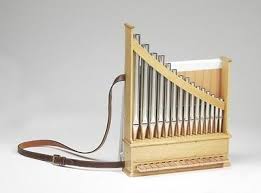
Oud – Literally, wood in Arabic, short-necked, pear-shaped with 11 – 13 strings grouped in 5, 6, or 7 courses. A few of the oud players that stand oud are Driss El Maloumi, a group called 3MA and Halk Egitim Merkezi Yalova, both Maloumi and Yalova perform with Jordi Savall’s Hesperion groups. The Oud is considered the most important instrument in Middle Eastern Music.
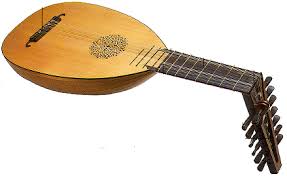
Qanun (a.k.a., kanun, ganoun, kanoon) an Arabic stringed instrument, introduced to Europe in the 12th Century. It’s played on the lap with picks that surround both index fingers, and the player can change the pitch of the strings with brass levers.
Hurdy Gurdy, a.k.a. Viola de Rueda, and the Zanfona. Here we hear this instrument in Musica Antigua and by a group called, BIDAIA, featuring Caroline Phillips.

Vielle – the Medieval fiddle with five strings and six tied frets.
Rebec – A three-string “fiddle” often held between the legs as it’s played.
Viola de Gamba – (a.k.a., Viol or gamba), a six-stringed instrument, said to be a precursor of the four-stringed cello. The Gamba, usually, is much larger and has frets, like a guitar. Pictured here, the great Jordi Savall.
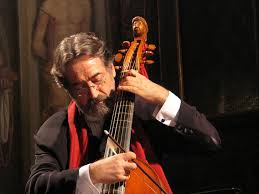
Gaita – Galician bag pipe, also common in Portugal. We’ll hear the Gaita in the next hour of this musical journey. Pictured here, Cristina Pato.
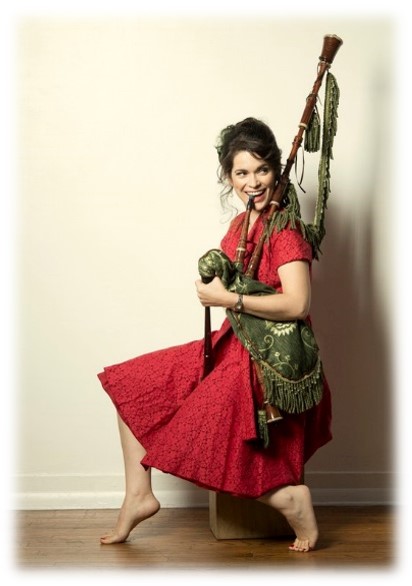
Duduk – Double reed Armenian flute, featuring those mournful, lamenting tones.
Let’s listen to another Cantiga de Loor, a lively dance, CSM#20 and CSM#353 – A rich man in Venice sent his son to live in a monastery to be raised by the abbot. The abbot, who called the boy his son, let him play in the cloister. While playing, the boy would go into the church to admire a statue of the Virgin and Child. Captivated by the Christ Child, the boy visited often and gave the Christ Child food. He promised to bring the Christ Child food every day, for 15 days, and encouraged him to eat. Then the statue of the Child spoke to the boy, bidding him to eat at his Father’s table the next day.
The abbot noticed that the boy was growing thin. The boy said that he had been sharing his food with the Child on the altar and said that the Christ Child had asked him to dinner. That night both the abbot and the boy fell ill; at the sixth hour they were taken to heaven.
Performed here by the Swiss Medieval music ensemble Freiburg Spielleyt. (Free-borg Schpee-loyta), we hear CSM#20 and CSM#353 7:10
-Freiburg Spielleyt performing CSM #20 and CSM #353 here on Cantigas de Santa Maria, a musical biography of King Alfonso X.
You’re listening to a musical journey of 13th Century Spain’s King Alfonso the X and his devotion to the Virgin Mary.
Alfonso X ruled from 1252 to 1284. To put the world into perspective at the time, the English language continued to change from its Germanic-rooted Olde English of the Beowulf poet (circa 9th or 10th century) after the Norman invasion of 1066. In the next century, we hear the English of Geoffrey Chaucer and the Gawain Poet. Europeans now use Arabic numerals in favor of Roman Numerals. In the Mongol Empire, Mongke, officially, marks the worship of his grandfather, Genghis Khan while Buddhism, Islam, and Christianity flourish. The Inca Empire of Peru is thriving. England begins the process of segregation of Jewish peoples, and other countries begin to follow suit. The Mexica people, also known as Aztecs are building their great city on a lake in what is now Mexico City. King Alfonso X’s bid to be King of the Holy Roman Empire fails in favor of Count Rudolf, bringing prominence to the Habsburg family, Rudolf was considered mediocre as Alfonso was to ambitious.
This body of work was written in the language of the time, Galician-Portuguese. Scholars argue today that Galician and Portuguese are dialects of the same language. As you hear it, it will remind you more of Portuguese than of Castilian, the root language of modern day Spanish, and you will hear the softly spoken syllables of the Portuguese language, Portugal being directly south of Galicia, which was home to the Celts the Sephardim, the Jewish peoples of the Iberian Peninsula. We hear now from the band, Milladoiro (Millan-dwowro), often compared to Ireland’s Chieftains. Performing on the regional instruments of the Gaita (Galician bagpipes) Ullean pipes, flutes, whistles, button accordions along with guitar and bouzouki. We hear their interpretation of CSM #49, The Lost Pilgrims led to Soissons by the Virgin after they lost their way in the mountains and prayed to her. It will be followed by a traditional Galician tune, Alalás da Ulla.
CSM#49 4:41
Alalás da Ulla 4:49
Traditional, Alalas da Ulla – You’re listening to Las Cantigas de Santa Maria, a musical biography of King Alfonso X, I’m your host, Debra Bolton.
Hour 2, Segment One:
Begin with the Prologue by Waverly Consort Cuts 1 and 2: 3:45
Hello, and welcome to hour two of Las Cantigas de Santa Maria, the musical biography of Medieval King of Castile-Leon, Alfonso X, the wise and learned. I’m your host, Debra Bolton.
We just heard an interpretation of the prologue, where the wise King announces himself in the role as the Virgin Mary’s troubadour. The Waverly Consort, founded by Kay and the recently deceased Michael Jaffe performed that piece.
Alfonsine scholar, Dr. Jessica Knauss describes the importance of the Cantigas de Santa Maria saying, “The most appropriate single adjective for the corpus of cultural work produced under Alfonso X is ‘encyclopedic.’” He wrote books of history, astronomy/astrology, law, poetry and music. Even his written leisure activities continue to survive the vagaries of time, bearing the King’s name as patron or author.”
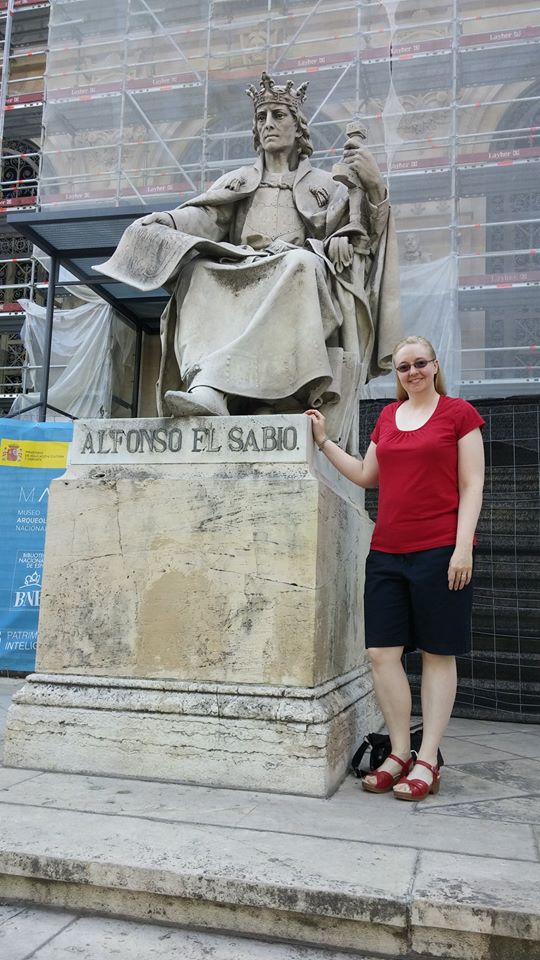
In Las Cantigas de Santa Maria, the CSM, we witness a general feeling that 13th century Castile is a rather unsafe place populated with people who engage in counter-productive behavior, according to Dr. Knauss. However, a point to ponder would be to write songs and poems, or commission works of arts to correspond with the songs and poems that contrasted good and evil. How are we to know what is righteous if we don’t know what is truly evil, asks the learned king. For example, CSM 34 tells the story of a man who disgraced an image of the Virgin hanging in a street in Constantinople. The man finished his deed by throwing the image in a latrine. As the story goes, the devil killed him and the people washed the image and cleaned it with sweet spices. From then on, the image emitted a sweet smelling oil as a testimony of this event. We hear Ensemble Alcatraz, from their album “Visions and Miracles.” (Cut 6, 8:04).
That was Ensemble Alcatraz, from their album “Visions and Miracles,” CSM#34, the story of a man’s not-so-nice deeds.
For more perspective of the time, King Henry III ruled England about the same time Alfonso X ruled Castile-Leon, the greater part of what is now known as Spain. While El Sabio ruled his lands with Christians, Muslims, and Jewish peoples living and studying side-by-side with some appreciation and great tolerance, it would not be until 208 years later that Isabella and Ferdinand would expel all non-Christians and the time Christopher Columbus would set sail for Asia but landed in the Americas, which changed extensively the lives that he touched. Before that, well-civilized Indigenous tribes had not yet had contact with European colonialists. The surnames that most people connect with Latin American countries were the surnames of their Spanish conquerors. During and after the inquisition, many non-Christians, Jewish and Muslim people, added the suffixes of –ez, -es, or -os to their surnames. For example, the Muslim man, Alvar, became Alvarez. The Jewish man, Martin became Martinez. Consistent with most surnames, there remained a connection to the family trade or place of origins. The Herrera were Jewish iron-smiths. Those hailing from Galicia, or Galego, were the Gallegos.
The music of the time, including the Cantigas de Santa Maria, demonstrate a heavy influence of the people who were in Castile-Leon. Here we have interpretations of CSM performed by Camerata Mediterranean under the direction of Joel Cohen and Mohammed Briouel. We hear two Cantiga de Loor, the songs of love, CSM #230 and #130 (Cuts 8 and 9, 7:00)
(Follow with Voice of the Turtle – La Prima Vez (Cut 1, 3:10)
Poder a Santa Maria – Syfonye, Taquism (Cut 5, 3:21)
Second Segment, Second Hour
You’re listening to Las Cantigas de Santa Maria on this public radio station. I’m your host, Debra Bolton, and I appreciate that you’re here with me today.
Before that short break we heard a group based in Massachusetts and Turkey called, Voice of the Turtle exploring the music of the Spanish Jewish peoples of Spain an Turkey.
(Go directly to the Prologue and Cantiga de Loor performed by Theatrum Instrumentorum (Cuts 1 and 2, 4:34)
That was Theatrum Instrumentorum performing a prologue, speaking of Alfonso’s devotion to the Virgin Mary followed by a song of love, Cantiga de Loor.
El Sabio, King Alfonso the X ascended the throne of Castile-Leon, now Spain, in 1252 and immediately devoted himself to the creation of new laws, the Siete Partidas (seven parts) and the Fuero Real (Royal Municipal Code), both of which continue to be in effect here in the 21st Century.
Alfonsine scholar, Dr. Jessica Knauss posits that the CSM continue to be a testament by which the king wished to be remembered after his death. That means that we, also, are part of the intended audience. Knauss continues that the learned king, likely, did not fathom this kind of dissemination, now in this digital age. She says, “With these technologies, it grants scholars who study the CSM a place in his highly exclusive circle of apprentices.”
Here we have a group focused on the music of the Middle Ages with their interpretation of CSM#100. Then we hear from another of the great and contemporary apprentices of Alfonso X is Eduardo Paniagua who leads the Musica Antigua, performing CSM#77, the story of a contorted woman in Lugo, who prayed to the Virgin and since was relieved of her paralysis.
Sonus (Cut 2, 4:31)
Musica Antigua, CSM #77 (Cut 2, 4:58)
That was Musica Antigua with CSM#77 in which you heard the hurdy gurdy, a chorus, flutes, psaltry, and Egyptian hand drum, among others. Before that, Sonus, featuring Hazel Ketchum, and their interpretation of a song of love to the Virgin.
![]()
In my exploration of the Cantigas de Santa Maria, I continue to celebrate the creativity in which musicians arrange their interpretations of the CSM into their musical genres. Hesperus is one of the band who have made Medieval and Appalachian genres sit very well side by side. This is a song made popular by Doc Watson, Little Sadie with a CSM tune woven in. We’ll follow that with Jazz guitarist, Frederick Hand and his interpretation of a CSM tune.
Thank you for listening to Cantigas de Santa Maria, I’m Debra Bolton (Pictured here with Jordi Savall)
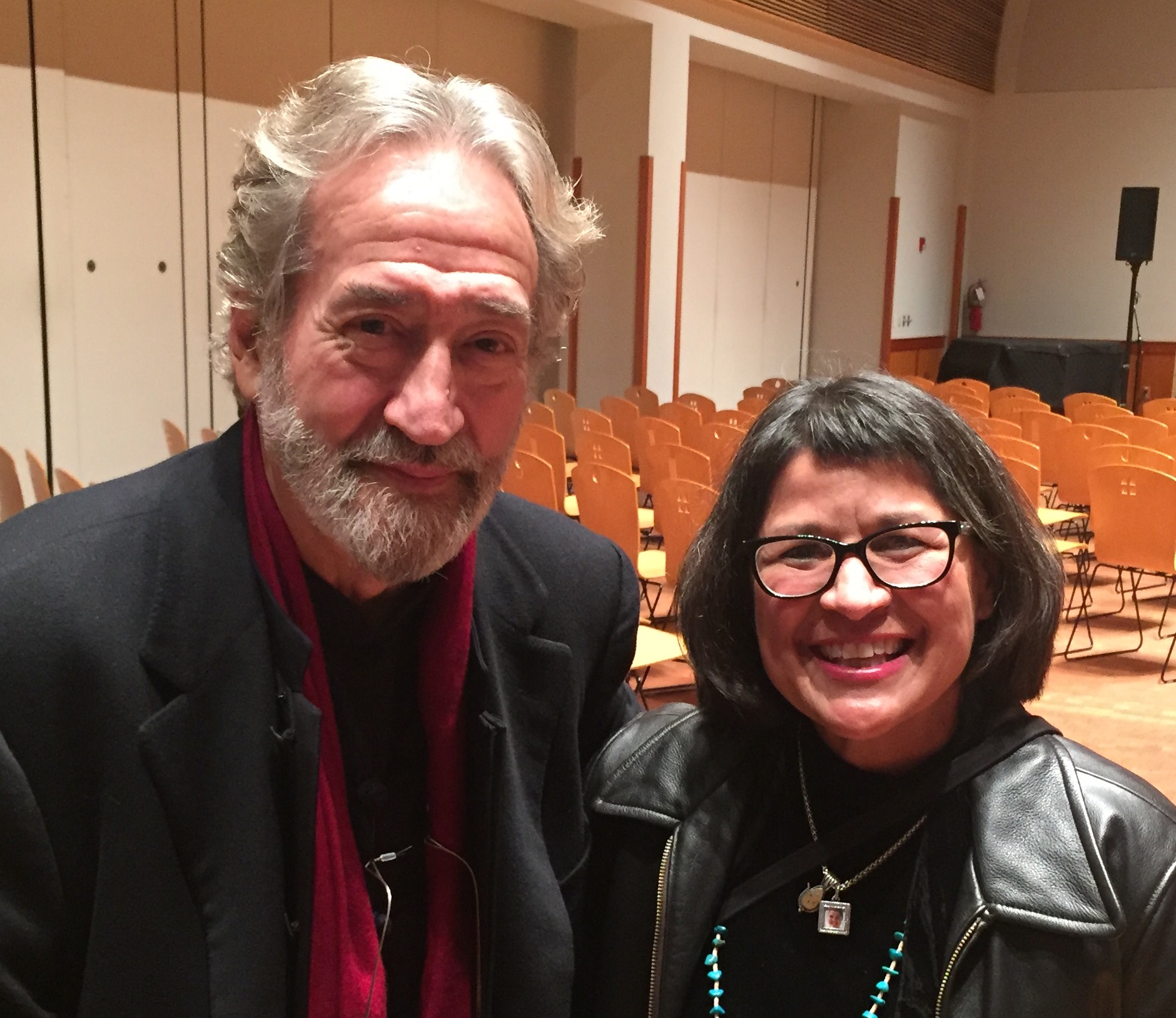
Hesperus, (Cut 4, 3:44)
Frederick Hand – CSM 100, (Disk#67, Cut 3, 4:36)
Thank you for reading, and I hope you get to listen to this show on your local public radio station.
I’d never heard of the king.. What a refreshing contrast to the horrors that came later.
LikeLiked by 1 person